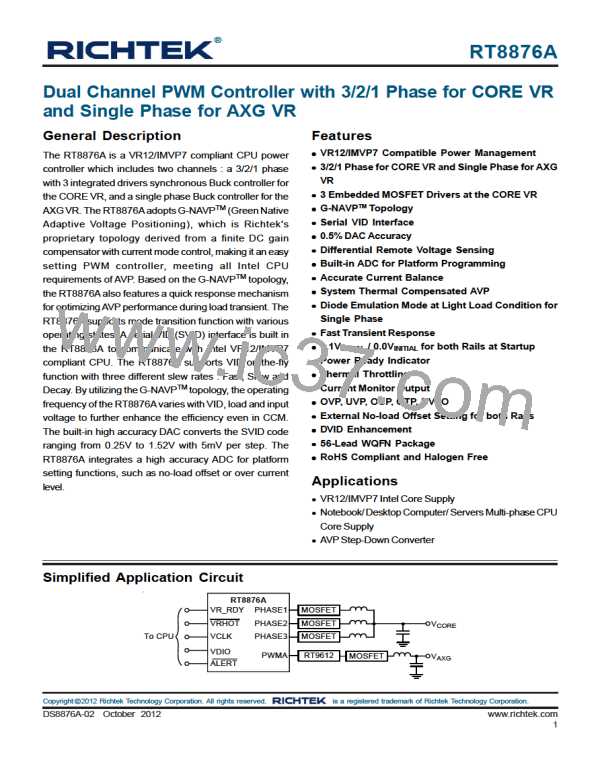RT8876A
or theDCR of the inductor), and RDROOP is the equivalent
load line resistance as well as the desired static output
impedance. Since theDCR of the inductor is temperature
dependent, the output accuracy may be affected at high
temperature conditions. Temperature compensation is
recommended for the lossless inductorDCR current sense
method. Figure 20 shows a simple but effective way of
compensating the temperature variations of the sense
resistor by using anNTC thermistor placed in the feedback
path.
For a givenNTC thermistor, solving equation (37) at room
temperature (25°C) yields
R2 = AV, 25°C x (R1b + R1a // RNTC, 25°C
)
(40)
whereAV, 25°C is the error amplifier gain at room temperature
and can be obtained from equation (35). R1b can be
obtained by substituting (40) to (36),
R1b =
RSENSE, HOT
×(R1a // RNTC, HOT ) − (R1a // RNTC, COLD
RSENSE, COLD
)
RSENSE, HOT
⎛
⎜
⎝
⎞
⎟
⎠
C2
C1
1−
RSENSE, COLD
(41)
R2
R1a
R1b
COMPA
V
CCAXG_SENSE
Loop Compensation
FBA
R
NTC
-
EA
RGNDA
V
+
SSAXG_SENSE
Optimized compensation of the AXG VR allows for best
possible load step response of the regulator's output. A
type-I compensator with one pole and one zero is adequate
for a proper compensation. Figure 20 shows the
compensation circuit. Previous design procedure shows
how to select the resistive feedback components for the
error amplifier gain. Next, C1 and C2 must be calculated
for compensation. The target is to achieve constant
resistive output impedance over the widest possible
frequency range.
V
DAC,AXG
Figure 20. AXGVR : Loop Setting with Temperature
Compensation
Usually, R1a is set to equal RNTC (25°C) and R1b is selected
to linearize the NTC's temperature characteristic. For a
given NTC, the design procedure is to get R1b and R2
first, and then C1 and C2 next.According to equation (35),
to compensate the temperature variations of the sense
resistor, the error amplifier gain (AV) should have the same
temperature coefficient as RSENSE. Hence :
The pole frequency of the compensator must be set to
A
R
SENSE, HOT
compensate the output capacitor ESR zero :
V, HOT
(36)
=
A
R
SENSE, COLD
V, COLD
1
fP =
(42)
2× π× C×RC
From (33), Av can be obtained at any temperature (T°C)
as :
where C is the capacitance of output capacitor, and RC is
the ESR of output capacitor. C2 can be calculated as
below :
R2
A
=
(37)
V, T°C
R1a // R
+ R1b
NTC, T°C
C×R
R2
C
(43)
C2 =
The standard formula for the resistance ofNTC thermistor
as a function of temperature is given by :
The zero of compensator has to be placed at half of the
switching frequency to filter the switching related noise.
⎡
1
1
298
⎤
β
−
(
(
{
⎢
⎣
⎥
⎦
T+273
(38)
RNTC, T°C = R25°C
e
Such that,
1
where R25°C is the thermistor's nominal resistance at room
temperature, β is the thermistor's material constant in
Kelvins, and T is the thermistor actual temperature in
Celsius. To calculateDCR value at different temperatures,
use the equation below :
C1 =
(44)
R1b + R1a // R
× π× f
SW
(
)
NTC, 25°C
TON Setting
High frequency operation optimizes the application by
allowing smaller component size, but with the trade-off of
efficiency due to higher switching losses. This may be
acceptable in ultra portable devices where the load currents
DCRT°C = DCR25°C x [1+ 0.00393 x (T − 25)]
(39)
where 0.00393 is the temperature coefficient of copper.
Copyright 2012 Richtek Technology Corporation. All rights reserved.
©
is a registered trademark of Richtek Technology Corporation.
DS8876A-02 October 2012
www.richtek.com
41

 RICHTEK [ RICHTEK TECHNOLOGY CORPORATION ]
RICHTEK [ RICHTEK TECHNOLOGY CORPORATION ]